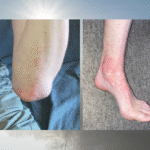 Freshers’ Week, the week that starts off the whole University experience, is a week that I remember when I was a 1st year medical student in London 31 years ago. From memory, it generally involves a lot of alcohol in the guise of pub crawls, themed parties and a variety of audacious dares to be performed around town in various states of undress.
Freshers’ Week, the week that starts off the whole University experience, is a week that I remember when I was a 1st year medical student in London 31 years ago. From memory, it generally involves a lot of alcohol in the guise of pub crawls, themed parties and a variety of audacious dares to be performed around town in various states of undress.
This year, my opinion was asked of a new onset rash in a healthy 19-year old with no previous history of skin problems. The rash was itchy and bumpy. It looked like urticaria and the person themselves described it looking like hives. It was the distribution that was a bit odd, being just on the feet and ankles and elbows.
I suggested it could be viral, as it is that time of year when the viruses are flourishing and the person did report that they felt slightly unwell, or to be precise, hungover as it was Freshers’ Week, after all.
On further questioning, it transpired that the person had undertaken a dare to lie down in a public fountain the night before. When asked directly, only his feet, ankles and elbows had been in contact with the water in the fountain, a sort of plank in my mind’s eye.
What’s the diagnosis?
I quickly changed my diagnosis from viral induced urticaria to swimmer’s itch.
What is swimmer’s itch?
Believe it or not, but I had only recently heard about swimmer’s itch from a friend who enjoys open water swimming regularly, presumably because the rash is gone by the time one sees a Consultant Dermatologist. They had been asking for a cream to treat the itch.
What causes swimmer’s itch?
It is a skin reaction caused by an allergic reaction to the larval forms of parasitic flatworms (schistosomes). These flatworms are released from infected aquatic snails into bodies of water, eg lakes and ponds usually in the summer months.
These flatworms’ preferred hosts are birds or other mammals. The flatworm eggs are excreted into water by the bird/animal which then infect aquatic snails which then release the cercarial form into the water.
The cercarial form will prefer to burrow back into the skin of a bird or mammal but if they come into contact with a swimmer, they will burrow into human skin just as well.
What does swimmer’s itch look like?
It can happen within hours of exposure to infected water with tiny red spots where the cercariae have burrowed into the skin. These then become itchy, the spots can get larger, develop into hives and may even blister. They can get secondarily infected if the spots gets scratched.
The clue is that it is usually only skin exposed to infected water that gets affected.
So it can happen the first time I am exposed to infected water?
As it is an allergic reaction, technically there should be no rash with the first exposure. However, repeated exposure will cause more immediate and severe symptoms each time. Indeed, in this case, I had been informed that they had been in the same fountain in last year’s Freshers’ Week with no problems and that the rash only occurred this year for the first time.
Is it contagious to others?
No, it cannot spread from person to person but if others get exposed to the infected water, they too can get the same rash.
And what is the treatment?
There is no specific treatment as it will resolve on its own, provided there is no further contact with the infected water. Any treatment usually involves measures to reduce itch such as oral and topical antihistamines, topical steroids & moisturisers.
The rash should resolve within a week or two.
What can be done to prevent it happening?
Rinse your skin as soon as possible after exposure or towel rub your skin straight after leaving the water to remove the parasites from your skin. If you are a fan of open water swimming, covering your skin with a wetsuit, gloves, boots and swim cap will reduce the amount of skin exposed.
Avoidance of swimming in shallow warm waters where there are lots of plants or which are visited by lots of water birds in the summer or early autumn will help. In the colder months, the cercariae die off.
The index case did indeed recover within a week and hopefully, my advice will mean that it won’t happen again in next year’s Freshers’ week!
Kind regards,
Sandy
Dr Sandy Flann, Consultant Dermatologist.
